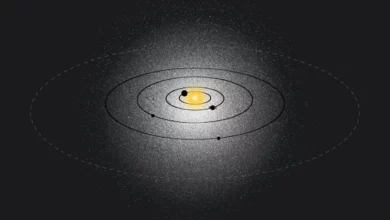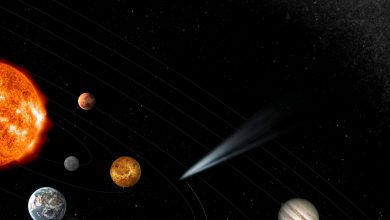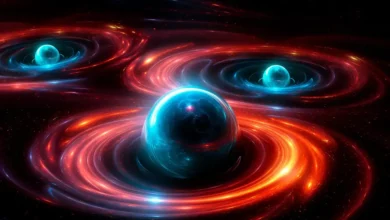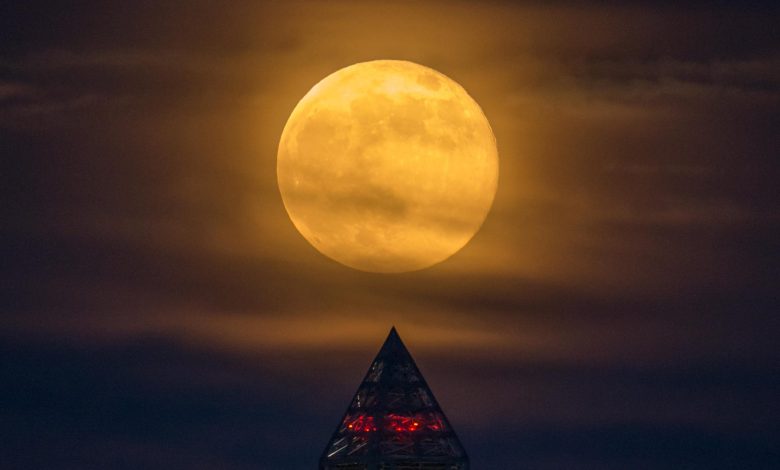
Lead Image: A supermoon rises behind the Washington Monument, Sunday, June 23, 2013, in Washington. Credit: NASA/Bill Ingalls
The next full moon is a marginal supermoon and is called the Sturgeon Moon. It’s also known as the Green Corn Moon, the Raksha Bandhan Festival Moon, Nikini Poya, the end of the Esala Perahera Festival, and the Tu B’Av Holiday Moon.
The next full moon will be Thursday night, August 11, 2022, appearing opposite of the Sun in Earth-based longitude at 9:36 p.m. EDT (6:36 p.m. PDT). This will be on Friday morning for the time zones east of Cape Verde time, which includes Coordinated Universal Time (UTC), the time zone used by most commercial calendars. The Moon will appear full for about three days from Wednesday morning through Saturday morning. The planet Saturn will appear near the Moon. Saturn will be near its brightest for the year, which will occur just a few days later.
One Moon, Many Names
Some of the most widely known and used names for full moons come from the Maine Farmer’s Almanac, which began publishing Native American names for the full moons in the 1930s. According to this almanac, the Algonquin tribes in what is now the northeastern United States called the full moon in August the Sturgeon Moon after the large fish that were more easily caught this time of year in the Great Lakes and other major bodies of water. This Moon was also known as the Green Corn Moon.
This full moon corresponds with the Hindu festival Raksha Bandhan, celebrating the bond between brothers and sisters. One of the traditions is for sisters of all ages to tie a rakhi (a cotton bracelet) around their brother’s wrist, receiving a gift from the brother in return, as a sign of the continuing bond between them. The term “Raksha Bandhan” translates as “the bond of protection, obligation, or care.”
In Sri Lanka, every full moon is a holiday. This full moon is called Nikini Poya, commemorating the first Buddhist council that occurred about 2,400 years ago, sometime around 400 BCE. In Kandy, Sri Lanka, this full moon corresponds with the end of the Esala Perahera festival, also known as the Festival of the Tooth. It is a two-week Buddhist festival held each year.
The Sturgeon Supermoon
Some publications consider this to be a supermoon, as it is the third closest full moon of the year. The term “supermoon” was coined by astrologer Richard Nolle in 1979 as either a new or full moon that occurs when the Moon is within 90% of perigee, its closest approach to Earth. Since we can’t see new supermoons (except when the Moon passes in front of the Sun and causes an eclipse), what has caught the public’s attention are full supermoons, as these are the biggest and brightest full moons of the year. Since perigee varies with each orbit, different publications use different standards for deciding which full moons qualify. The full moons in June and July were closer.
The Moon and Calendars
In many traditional lunisolar and lunar calendars, full moons fall in the middle of the lunar months. This full moon is in the middle of the seventh month of the Chinese calendar and Av in the Hebrew calendar, corresponding with Tu B’Av, a holiday in modern Israel similar to Valentine’s Day. This full moon falls near the middle of Muharram in the Islamic calendar. Muharram is the first month of the Islamic year and one of the four sacred months during which warfare is forbidden.
For Science Fiction fans, a note on the author Theodore Sturgeon (in honor of the Sturgeon Moon). According to Wikipedia, Theodore Sturgeon wrote over 200 stories, mostly science fiction but some mystery and horror stories. For Star Trek fans, his scripts introduced important concepts into the series, although only two of his scripts were produced. His Star Trek scripts introduced “pon far,” the Vulcan hand symbol, the phrase “live long and prosper,” and (in a script that was not produced but that influenced later scripts) the “Prime Directive.”
As usual, the wearing of suitably celebratory celestial attire is encouraged in honor of the full moon. In addition, keep in touch with your siblings, avoid starting any wars, and consider reading some Theodore Sturgeon.
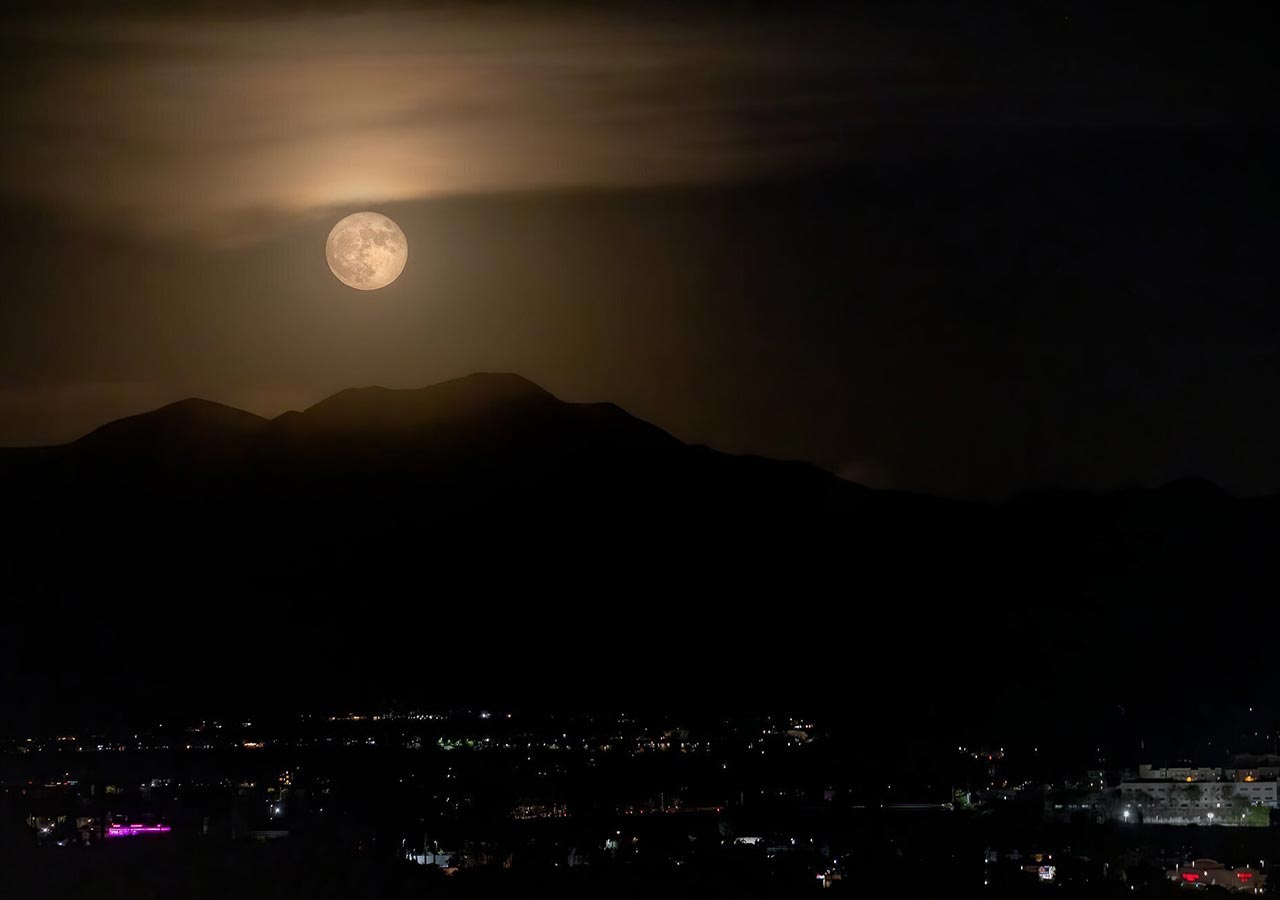
Here is a summary of celestial events between now and the full moon after next (with times and angles based on the location of NASA Headquarters in Washington, D.C.):
As summer continues the daily periods of sunlight continue to shorten. On Wednesday, August 11, 2022, the day of the full moon, morning twilight will begin at 5:14 a.m. EDT, sunrise will be at 6:18 a.m., solar noon will be at 1:13:20 p.m. when the Sun will reach its maximum altitude of 66.24 degrees, sunset will be at 8:08 p.m., and evening twilight will end at 9:11 p.m. By Saturday, September 10, the day of the full moon after next, morning twilight will begin at 5:46 a.m., sunrise will be at 6:45 AM, solar noon will be at 1:05:11 p.m. when the Sun will reach its maximum altitude of 55.88 degrees, sunset will be at 7:24 p.m., and evening twilight will end at 8:23 p.m.
Perseids vs the Moon
Several meteor showers are expected to peak during this lunar cycle, but moonlight will interfere with the most promising shower. According to the International Meteor Organization, the Perseid meteor shower is expected to peak late Friday night into early Saturday morning, August 12 to 13, 2022. Although the Perseids can be one of the major meteor showers of the year, in 2022 the nearly full moon will make it difficult to see these meteors. Should you look for these meteors, the best time will be after midnight on Saturday morning, you will need to be far from light pollution and other light sources and to find a place that has a clear view of a clear sky with no clouds or haze. You will need to look toward the north away from the light of the Moon. The other three meteor showers peaking during this lunar cycle are expected to peak at 3 to 6 meteors per hour at best (and fewer under urban viewing conditions).
Evening Sky Highlights
On the evening of Thursday, August 11, 2022, the day of the full moon, as evening twilight ends at 9:11 p.m. EDT, the rising Moon will appear 7 degrees above the east-southeastern horizon with the planet Saturn 6 degrees to the upper left of the Moon. The planet Mercury will have set about 4 minutes before but may be visible in the glow of dusk before it sets. The bright star appearing closest to directly overhead will be Vega at 76 degrees above the eastern horizon. Vega is the 5th brightest star in our night sky, about 25 light-years from Earth, twice the mass of, and 40 times brighter than our Sun.
As the lunar cycle progresses, Saturn and the background of stars will appear to shift westward each evening as Earth moves around the Sun. Saturn will be at its closest and brightest for the year on August 14, rising around sunset and setting around sunrise. Through much of August the planet Mercury will set just a few minutes before evening twilight ends but will be shifting to the left along the horizon farther from the Sun. This increases the chance Mercury will be visible in the glow of dusk. Toward the end of August Mercury will stop shifting away from the Sun, as it will reach its greatest separation from the Sun for this apparition on August 27, and will begin setting earlier each evening, making it harder to see. The waxing moon will pass near Mercury on August 29, the bright star Spica on August 30, the bright star Antares on September 3, and Saturn on September 7 and 8. Beginning around September 5, the bright planet Jupiter will begin appearing above the eastern horizon as evening twilight ends, joining Saturn in the evening sky.
By the evening of Saturday, September 10, the day of the full moon after next, as evening twilight ends at 8:23 p.m. EDT, the rising Moon will appear 4 degrees above the eastern horizon. Jupiter will appear to the left of the Moon less than 3 degrees above the eastern horizon. Saturn will appear 21 degrees above the southeastern horizon. Mercury will no longer be visible in the glow of dusk as it will set 30 minutes after sunset. The bright star Vega will appear almost exactly overhead at 89.5 degrees above the horizon.
Morning Sky Highlights
On the morning of Thursday, August 11, 2022, the day of the full moon, as morning twilight begins at 5:14 a.m. EDT, four of the five visible planets will appear spread across the sky, with Saturn at 14 degrees above the southwestern horizon, Jupiter at 51 degrees above the south-southwestern horizon, Mars at 55 degrees above the east-southeastern horizon, and Venus at 5 degrees above the east-northeastern horizon. The full moon will be setting on the west-southwestern horizon below Saturn. The bright celestial object appearing closest to overhead will be the planet Mars.
As the lunar cycle progresses, the background of stars along with Jupiter, Saturn, and Mars will appear to shift westward each morning, although Mars will appear to shift more slowly. Venus will appear to shift the opposite way, closer to the eastern horizon each morning. The Perseid meteor shower will peak on the morning of Aug, 13, but the light of the nearly full moon will interfere with seeing these meteors this year (especially with the added light pollution in more urban environments). Saturn will be at its closest and brightest for the year on August 14, rising around sunset and setting around sunrise. The waning moon will pass near Saturn on August 12, the bright planet Jupiter on August 15, Mars and the Pleiades star cluster on Aug/ 19, the bright star Aldebaran on August 20, the bright star Pollux on August 23 and 24, and the bright planet Venus on August 25 and 26. August 26 will be the last morning that Saturn will be above the west-southwestern horizon (as morning twilight begins) and September 6 will be the last morning that Venus will be above the east-northeastern horizon.
By the morning of Saturday, September 10, the day of the full moon after next, as morning twilight begins at 5:46 a.m. EDT, only two of the five visible planets will appear in the sky, with Jupiter at 29 degrees above the west-southwestern horizon and Mars at 70 degrees above the south-southeastern horizon near the bright star Aldebaran. The full moon will be 10 degrees above the west-southwestern horizon below the planet Jupiter. The bright star appearing closest to overhead will be Capella at 73 degrees above the east-northeastern horizon. Although we see Capella as a single star (the 6th brightest in our night sky), it is actually four stars (two pairs of stars orbiting each other). Capella is about 43 lightyears from us.
Detailed Daily Guide
Here is a more detailed, day-by-day listing of celestial events between now and the full Moon after next. The times and angles are based on the location of NASA Headquarters in Washington, D.C., so some of these details may differ for your location.
August 6-7
Saturday morning, August 6, 2022, low on the east-northeastern horizon, the bright star Pollux will appear 6.5 degrees to the upper left of the bright planet, Venus. Venus will rise (at 4:32 a.m. EDT) about a half-hour before morning twilight begins and will be 6 degrees above the east-northeastern horizon as twilight begins at 5:09 a.m. Venus will be shifting closer to the horizon each morning, while Pollux is shifting higher, and this will be the morning when the pair will appear at their closest.
Saturday evening into early Sunday morning, August 6 to 7, 2022, the bright star Antares will appear about 6 degrees to the left of the waxing gibbous moon. As evening twilight ends at 9:18 p.m. EDT, the Moon will appear 26 degrees above the south-southwestern horizon. The Moon will set below the west-southwestern horizon about 4 hours later at 1:04 a.m. on Sunday.
August 10
Wednesday afternoon, August 10, 2022, at 1:10 p.m. EDT, the Moon will be at perigee, its closest to Earth for this orbit.
August 11: The Full Sturgeon Supermoon
As mentioned above, the next full moon will be Thursday night, August 11, 2022, at 9:36 p.m. EDT. The Moon will appear full for about three days from Wednesday morning through Saturday morning.
The planet Saturn, nearly at its brightest for the year, will appear above the Moon Thursday night into Friday morning, August 11 to 12, 2022, shifting from the upper left to the upper right as the night progresses.
August 12-13: Perseid Meteor Shower Peaks
The Perseid meteor shower is expected to peak late Friday night into early Saturday morning, August 12 to 13, 2022. The moonlight will make it difficult to see these meteors this year. If you do decide to look for these meteors, the best time should be after midnight on Saturday morning. You will need to be far from the city or other light sources in a place with no clouds or haze and have a clear view of a large expanse of sky. You will need to look northward away from the glow of the Moon.
August 14
Midday on Sunday, August 14, 2022, the planet Saturn will be opposite Earth from the Sun (called “opposition”), effectively a “full” Saturn. Saturn will be at its closest to Earth for the year, appearing at its brightest.
On Sunday night into Monday morning, August 14 to 15, 2022, Jupiter will appear to the left of the waning gibbous moon. The pair will rise above the eastern horizon at 9:58 p.m. EDT with Jupiter about 6 degrees to the left of the Moon. The Moon will reach its highest in the sky for the night Monday morning at 4:02 a.m. with Jupiter about 4 degrees above the Moon, and morning twilight will begin a little more than an hour later at 5:19 a.m.
August 17
On Wednesday morning, August 17, 2022, with binoculars or a small telescope. you might be able to see the Beehive star cluster to the left of Venus. Venus will appear about 4 degrees above the east-northeastern horizon as morning twilight begins at 5:21 a.m. EDT.
August 19
Friday morning, August 19, 2022, the half-full waning moon will appear near Mars and the Pleiades star cluster. Mars will be the last to rise above the east-northeastern horizon at 12:02 a.m. EDT, appearing below the Moon, with the Pleiades to the left of the Moon. The Moon will reach its last quarter at 12:36 a.m. By the time morning twilight begins at 5:23 a.m., the Moon will appear nearly between Mars and the Pleiades, with the Pleiades to the upper left and Mars to the lower right. Mars and the Pleiades will appear at their closest the next morning, Saturday, August 20, about 6 degrees apart.
August 20
Saturday morning, August 20, 2022, the bright star Aldebaran will appear about 8 degrees to the lower right of the waning crescent moon. The Moon will rise first, then Aldebaran will rise above the east-northeastern horizon at 12:52 a.m. EDT. Morning twilight will begin about 4.5 hours later at 5:24 a.m.
August 22
Monday, August 22, 2022, at 5:53 p.m. EDT, the Moon will be at apogee, its farthest from Earth for this orbit.
August 23
Tuesday morning, August 23, 2022, the bright star Pollux will appear about 8 degrees to the lower left of the waning crescent moon. The Moon will rise first, then Pollux will rise above the northeastern horizon at 3:03 a.m. EDT, more than two hours before morning twilight begins at 5:28 a.m.
August 24
By Wednesday morning, August 24, 2022, the Moon will appear below the bright star Pollux. When the Moon rises above the east-northeastern horizon at 3:29 a.m. EDT it will join Pollux. Morning twilight will begin about 2 hours later at 5:29 a.m.
August 25
Thursday morning, August 25, 2022, the bright planet Venus will appear about 8 degrees below the thin, waning crescent moon. The Moon will rise first, then Venus will join the Moon when it rises above the east-northeastern horizon at 5:12 a.m. EDT. Morning twilight will begin about 18 minutes later at 5:30 a.m.
August 26
Friday morning, August 26, 2022, you might be able to see the thin, waning crescent moon about 7 degrees to the lower left of Venus. The Moon will rise to join Venus above the east-northeastern horizon right around the time morning twilight begins at 5:31 a.m. EDT.
August 27: New Moon
Saturday morning, August 27, 2022, at 4:17 a.m. EDT, will be the new moon, when the Moon passes between Earth and the Sun and will not be visible from Earth.
Midday on Saturday will be when the planet Mercury reaches its greatest angular separation from the Sun as seen from Earth for this apparition (called greatest elongation), appearing half-lit through a large enough telescope. Because the angle of the line between the Sun and Mercury and the horizon changes with the seasons, when Mercury and the Sun appear farthest apart as seen from Earth is not the same as when Mercury is easiest to spot in the glow of dusk shortly before evening twilight ends.
The day of or the day after the new moon marks the start of the new month for most lunar and lunisolar calendars. The eighth month of the Chinese calendar starts on Saturday, August 27, (at midnight in China’s time zone, which is 12 hours ahead of EDT). Sundown on Saturday, August 27, marks the start of Elul in the Hebrew calendar. Elul is a time of preparation for the High Holy Days of Rosh Hashanah and Yom Kippur. Customs include granting and asking others for forgiveness as well as beginning or ending all letters with the wish that the recipient will have a good year. In the Islamic calendar, the months traditionally start with the first sighting of the waxing crescent moon. Many Muslim communities now follow the Umm al-Qura Calendar of Saudi Arabia, which uses astronomical calculations to start months in a more predictable way. Using this calendar, sundown on Saturday, August 27, will probably mark the beginning of Safar.
August 29
For about 20 minutes on Monday evening, August 29, 2022, you might be able to see Mercury below the thin, waxing crescent moon. Try looking on the western horizon more than 30 minutes after sunset after 8:13 p.m. EDT but before Mercury sets at 8:35 p.m. The glow of dusk will make it hard to see the pair without binoculars or a telescope, as Mercury will set about 8 minutes before evening twilight ends at 8:43 p.m.
August 30
On Tuesday evening, August 30, 2022, the bright star Spica will appear about 5 degrees to the left of the thin, waxing crescent moon. The Moon will appear 9 degrees above the west-southwestern horizon as evening twilight ends at 8:41 p.m. EDT, and Spica will set first about 40 minutes later at 9:23 p.m.
September 3
On Saturday afternoon, September 3, 2022, the Moon will appear half-full as it reaches its first quarter at 2:08 p.m. EDT (when we cannot see it from the Washington, D.C. area).
On Saturday evening, the bright star Antares will appear about 6 degrees to the lower right of the half moon. The Moon will be 22 degrees above the south-southwestern horizon as evening twilight ends at 8:35 p.m. EDT, and Antares will set first on the southwestern horizon less than 3 hours later at 11:14 p.m.
September 6-8
Late Tuesday night into Wednesday morning, September 6 to 7, 2022, will be when Mars and the bright star Aldebaran appear near each other, a little more than 4 degrees apart. Mars will rise first, with Aldebaran rising above the east-northeastern horizon near midnight at 11:45 p.m. EDT. Mars will be 69 degrees above the southeastern horizon as morning twilight begins on Wednesday morning at 5:43 a.m.
Wednesday afternoon at 2:19 p.m. EDT, the Moon will be at perigee, its closest to Earth for this orbit.
On Wednesday night into Thursday morning, September 7 to 8, 2022, Saturn will appear above the waxing gibbous Moon. Saturn will be about 9 degrees to the upper left of the Moon as evening twilight ends (Wednesday at 8:28 p.m. EDT). The Moon will reach its highest in the sky for the night less than 3 hours later at 11:13 p.m. By the time the Moon sets below the west-southwestern horizon about 5 hours later (Thursday at 4:14 a.m.), Saturn will appear about 6 degrees to the upper right of the Moon.
September 10: The Full Moon After Next
The full moon after next will be on Saturday morning, September 10, 2022, at 5:59 a.m. EDT. The Moon will appear full for about three days from Thursday evening to Sunday morning.


